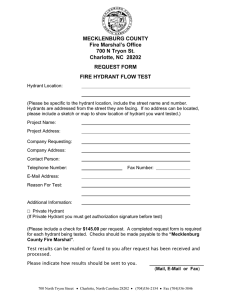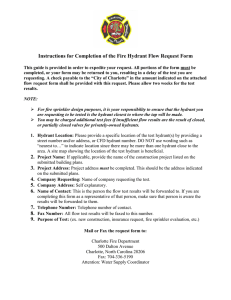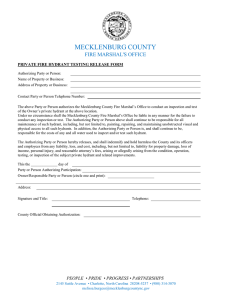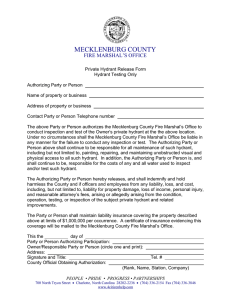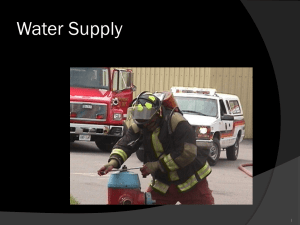Water Supply
advertisement
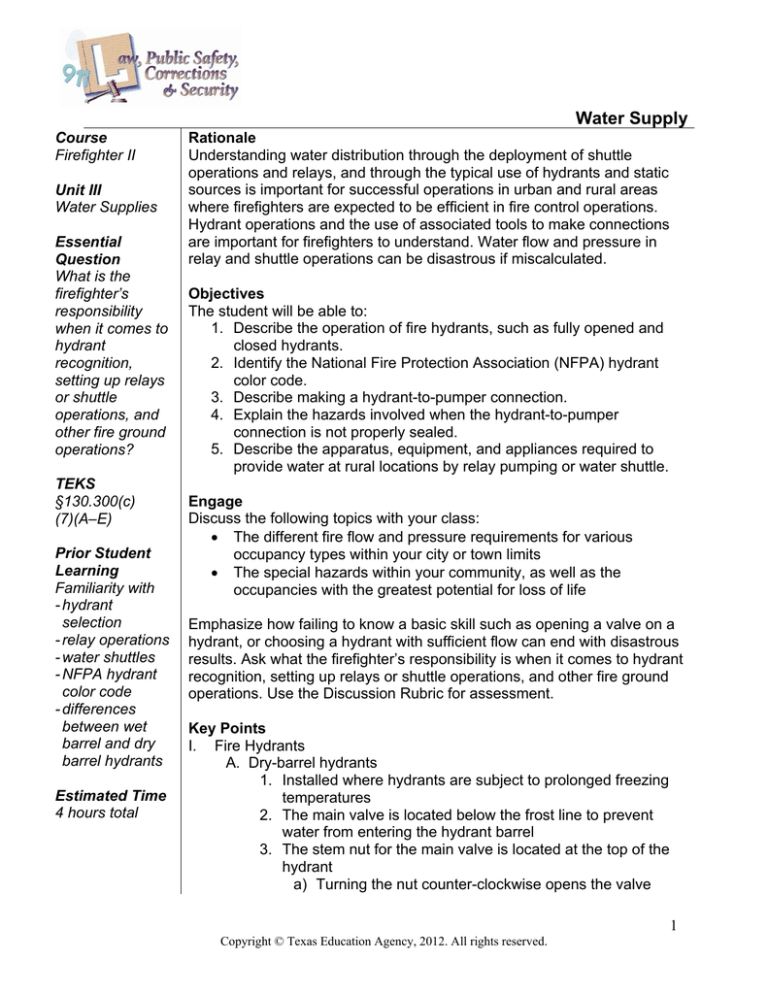
Water Supply Course Firefighter II Unit III Water Supplies Essential Question What is the firefighter’s responsibility when it comes to hydrant recognition, setting up relays or shuttle operations, and other fire ground operations? TEKS §130.300(c) (7)(A–E) Prior Student Learning Familiarity with - hydrant selection - relay operations - water shuttles - NFPA hydrant color code - differences between wet barrel and dry barrel hydrants Estimated Time 4 hours total Rationale Understanding water distribution through the deployment of shuttle operations and relays, and through the typical use of hydrants and static sources is important for successful operations in urban and rural areas where firefighters are expected to be efficient in fire control operations. Hydrant operations and the use of associated tools to make connections are important for firefighters to understand. Water flow and pressure in relay and shuttle operations can be disastrous if miscalculated. Objectives The student will be able to: 1. Describe the operation of fire hydrants, such as fully opened and closed hydrants. 2. Identify the National Fire Protection Association (NFPA) hydrant color code. 3. Describe making a hydrant-to-pumper connection. 4. Explain the hazards involved when the hydrant-to-pumper connection is not properly sealed. 5. Describe the apparatus, equipment, and appliances required to provide water at rural locations by relay pumping or water shuttle. Engage Discuss the following topics with your class: The different fire flow and pressure requirements for various occupancy types within your city or town limits The special hazards within your community, as well as the occupancies with the greatest potential for loss of life Emphasize how failing to know a basic skill such as opening a valve on a hydrant, or choosing a hydrant with sufficient flow can end with disastrous results. Ask what the firefighter’s responsibility is when it comes to hydrant recognition, setting up relays or shuttle operations, and other fire ground operations. Use the Discussion Rubric for assessment. Key Points I. Fire Hydrants A. Dry-barrel hydrants 1. Installed where hydrants are subject to prolonged freezing temperatures 2. The main valve is located below the frost line to prevent water from entering the hydrant barrel 3. The stem nut for the main valve is located at the top of the hydrant a) Turning the nut counter-clockwise opens the valve 1 Copyright © Texas Education Agency, 2012. All rights reserved. allowing water into the hydrant b) Turning the nut clockwise direction closes the valve, raising the drain valve plate which opens the drain holes and causes the barrel to empty 4. There is a process to verify that the water is draining from the hydrant a) Close the main valve until resistance is met, and then give it another ¼-turn b) Cap all but one discharge c) Place a hand over the open discharge – if the hydrant is draining, a slight vacuum is felt; if not then repeat the previous steps B. Wet-barrel hydrants 1. Sometimes referred to as “frost free” or “California” hydrants 2. Installed in climates where prolonged freezing is uncommon 3. Have a compression valve on each outlet that needs to be turned counterclockwise to open it 4. Do not drain when all of the valves are closed; the barrel stays filled with water II. NFPA Hydrant Color Code A. Class AA/Light Blue/1500 gallons per minute (gpm) or greater B. Class A/Green/1000–1499 gpm C. Class B/Orange/500–999 gpm D. Class C/Red/less than 500 gpm III. Making Hydrant Connections A. Associated tools 1. Combination spanner/hydrant wrench 2. Four-way hydrant valve (check local Standard Operating Procedures (SOPs)) 3. Items may be kept readily accessible in a tool pouch 4. The firefighter making the hydrant connection should maintain radio communication with the pump operator as to when to supply water from the hydrant (some departments use an audio or a hand signal in addition, or in place of, radio communication) B. Hydrant connection procedure for a forward lay (hose laid from the water source to the fire) 1. The firefighter a) Takes the necessary tools to make the hydrant connection b) Removes sufficient hose from the supply bed to “wrap” the hydrant c) Wraps the hose around the base of the hydrant, and effectively anchors the hose to it 2 Copyright © Texas Education Agency, 2012. All rights reserved. d) Signals the driver/operator to proceed to the fire (forward lay) e) Makes the proper hose connections to the hydrant C. Using a four-way valve 1. Four-way valves allow a) Forward laid supply lines to be charged immediately b) Additional pumpers to connect to the hydrant 2. The second pumper either supplies more lines or boosts the pressure of the original supply line 3. Typically, the four-way valve is pre-connected to the supply line, to be readily connected to the hydrant a) This allows the firefighter “catching” the hydrant to have to complete only the one task of making the valve connection to the hydrant D. Reverse lay (hose laid from the fire to the water source) 1. The method used when firefighters a) Take the apparatus to the fire location b) Complete a size-up before laying a supply line c) Leave the necessary equipment at the scene d) Lay the supply line back to the water source 2. Used primarily when drafting, or when there is a need to boost hydrant pressure for the supply lines 3. There is often an SOP for setting up relay operations with 2½- or 3-inch supply lines 4. Some disadvantages a) Leaving essential equipment before laying the supply lines can cause delays in the initial attack of a fire b) One firefighter is obligated to remain with the pumper at the water source as opposed to being at the fire scene 5. Does not require the employ of a four-way valve 6. Can be used when one pumper is alone for an extended period of time and the hose used in the reverse lay becomes the attack line (often used with a wye and a 1½- or 1¾-inch attack assembly) 7. Reverse lays when using two pumpers a) One arrives at the scene and begins extinguishment operations b) The second lays a supply line back to the water source c) That line is connected to the intake side of the first pumper at the scene IV. Hydrant Connections with a Soft Intake Hose A. A firefighter will assist the pump operator in making a soft intake hydrant connection B. Some hydrants are not capable of making a large soft intake hose connection because they are not equipped with a steamer 3 Copyright © Texas Education Agency, 2012. All rights reserved. connection; therefore, only a smaller dimension supply hose can be used C. It is more efficient use of a hydrant if a connection can be made to a large steamer connection with a 4½-inch or larger supply line D. Because a hydrant is a pressurized water source, a soft intake hose is appropriate and works effectively V. Hydrant Connections with a Hard Intake Hose A. If a hard intake hose is marked “For Vacuum Use Only,” do not use it for hydrant connections; this type of hard intake hose is meant for drafting operations only B. This method may require the coordination of more people to attach than the connection with a soft intake hose would C. The positioning of the pumper prior to making the connection is critical (depending on the apparatus, connections may be possible from either the side, front, or rear of the apparatus) D. It is good practice to stop the apparatus just short of the hydrant and jockey the apparatus into position in order to make the connection E. Making this type of connection takes practice and precision VI. Meeting Water Needs A. Hydrant connections need to be made correctly for the following reasons: 1. To sustain the fire flow requirements and pressure needs of the systems and the appliances served 2. To effectively save lives and property from fire damage 3. To avoid tragedies caused by ineffective pumper-to-hydrant connections a) A poor or no water supply for extinguishment endangers the building occupants and the firefighters b) A poor or no water supply can result in poor exposure protection and the extension of the fire beyond the building of origin B. Firefighters should know the normal and flow pressures of water distribution systems, as well as their flow capacities 1. High flow/high pressure systems or areas can be an advantage to firefighting operations 2. Low flow/low pressure systems or areas should be avoided if possible 3. When pumping from a hydrant, the recommended low residual pressure is 20 psi 4. Average pressures in water distribution systems in the United States are between 65 and 80 psi, with a typical minimum residual pressure of 20 psi 4 Copyright © Texas Education Agency, 2012. All rights reserved. VII. Rural Water Supply Operations A. Water shuttles are recommended for distances greater than half a mile, or distances greater than the supply line capability of the department B. Tools and/or equipment needed 1. Attack engine (pumper) 2. Supply line 3. Supply engine 4. Low level strainers 5. Portable tank(s) 6. Water tenders 7. Drafting engine (unless self-filling vacuum tenders are used) 8. Water source C. Relay pumping 1. In some situations, the water source is close enough to the scene (within supply line capability of the department, and closer than ½ mile) that relay pumping can be used instead of water shuttles 2. Two factors to consider a) Is the water supply capable of maintaining the necessary volume of water for the time required to mitigate the incident? b) Can the relay operation be set up quickly enough to be effective? 3. Tools and/or equipment needed a) Water supply b) Apparatus with the greatest pumping capacity at the water source c) Large diameter supply hose d) Attack pumper Activities 1. Operating a Dry Barrel Fire Hydrant. Have the students correctly connect to and operate a fire hydrant while wearing PPE. Use the Operating a Dry Barrel Fire Hydrant Checklist for the activity and the assessment. Note: Set up the hydrant, hydrant tools, and supply hose before class. 2. Connect and Place a Hard Suction for Drafting. Have the students correctly connect to the fire apparatus in preparation of drafting from a static water source while wearing PPE. Use the Connect and Place a Hard Suction for Drafting Checklist for the activity and the assessment. Note: Set up the hydrant, hydrant tools, and hard suction supply hose before class. 5 Copyright © Texas Education Agency, 2012. All rights reserved. Assessments Water Supply Quiz Operating a Dry Barrel Fire Hydrant Checklist Connect and Place a Hard Suction for Drafting Checklist Discussion Rubric Individual Work Rubric Research Rubric Materials Water Supply computer-based presentation Personal Protective Equipment (PPE) Hydrant Hard suction hose Soft sleeve hose Hydrant wrenches Spanner wrenches Strainer Hose rope Fire apparatus Computers with Internet access Resources 0135151112, Essentials of Firefighting (5th Edition), International Fire Service Training Association (IFSTA), 2008 1428339825, Firefighter's Handbook: Firefighter I and Firefighter II (1st Edition), Delmar Cengage Learning, 2008 Accommodations for Learning Differences For reinforcement, students will work in teams and practice using the hydrant tools and rolling hose segments. Use the Individual Work Rubric for assessment. For enrichment, students will research the history of fire hydrants and write a short paper summarizing their findings. Use the Research Rubric for assessment. State Education Standards Texas Essential Knowledge and Skills for Career and Technical Education §130.300. Firefighter II (Two to Three Credits). (7) The student explains how to deploy portable water tanks as well as equipment to transfer water between tanks. The student is expected to: (A) describe the operation of fire hydrants such as fully opened fire hydrants and closed fire hydrants; (B) identify the National Fire Protection Association 6 Copyright © Texas Education Agency, 2012. All rights reserved. (C) (D) (E) hydrant color code; describe making a hydrant-to-pumper connection; explain the hazards involved when the hydrant-topumper connection is not properly sealed; and describe the apparatus, equipment, and appliances required to provide water at rural locations by relay pumping or water shuttle. College and Career Readiness Standards Cross-Disciplinary Standards I. Key Cognitive Skills E. Work habits 1. Work independently. 2. Work collaboratively. 7 Copyright © Texas Education Agency, 2012. All rights reserved. Name________________________________ Date__________________________ Water Supply Quiz 1. _____ To flow water from a dry-barrel hydrant a. Turn the stem nut counterclockwise to allow water into the hydrant b. Turn the stem nut clockwise to allow water into the hydrant c. Open the compression valve counterclockwise to fill the discharge outlet d. Open the compression valve clockwise to fill the discharge outlet 2. _____ Which of the following statements about wet-barrel hydrants is false? a. Each outlet on a wet-barrel hydrant has its own compression valve that needs to be turned (counterclockwise) to open it b. The hydrant does not drain when all the valves are closed; the barrel is always filled with water c. They are sometimes referred to as “frost free” or “west coast” hydrants d. All of the above statements are true 3. _____ According to the NFPA Hydrant Color Code, Class A hydrants are: a. Light blue with a 1500 or greater gpm flow b. Green with a 1000 to 1499 gpm flow c. Red with a gpm flow of less than 500 d. Yellow with a 500 to 999 gpm flow 4. _____ What does a four-way valve allow firefighters to do? a. Allow forward laid supply lines to be charged immediately b. Connect additional pumpers to the hydrant c. Boost pressure in the original supply line d. All of the above 5. _____ Hydrant connections with a soft intake hose are more efficient when the connection can be made to a steamer connection using a ____ inch or larger supply line. a. 4 b. 4½ c. 5 d. 6½ 8 Copyright © Texas Education Agency, 2012. All rights reserved. 6. _____ A soft intake hose is appropriate to use to make a hydrant connection with because a. It comes in a larger diameter than a hard intake hose b. Most hydrants have steamer connections c. Hydrants are a pressurized water supply d. None of the above 7. _____ A hard intake hose marked with “For Vacuum Use Only” a. Is meant for pressurized water sources only b. Is designed for relay operations only c. Is designed for shuttle operations only d. Is meant for drafting use only 8. _____ Hydrant connections need to be made correctly a. To sustain the fire flow requirements and pressure needs of systems and appliances served b. To effectively save lives and property from fire damage c. To provide adequate exposure protection and to stop the extension of the fire beyond the building of origin d. All of the above 9. _____ When pumping from a hydrant, the recommended low residual pressure is how many psi? a. 10 b. 15 c. 20 d. 25 10. _____ Water shuttles are recommended for distances greater than ___ mile(s) or for distances greater than the supply line capability of the department. a. ¾ b. ½ c. 1 d. 2 9 Copyright © Texas Education Agency, 2012. All rights reserved. Water Supply Quiz Key 1. A. 2. C 3. B 4. D 5. B 6. C 7. D 8. D 9. C 10. B 10 Copyright © Texas Education Agency, 2012. All rights reserved. Name: _________________________ Date: __________________________ Operating a Dry Barrel Fire Hydrant Checklist Directions – Using the hydrant, hydrant tools, and supply hose you are given, correctly connect to and operate the fire hydrant while wearing Personal Protective Equipment (PPE). You will begin on my instructions to start. The skill will end when you state to me that you have completed all of the identified steps. Do you understand these instructions? 1 pt. each Performance Objectives Wrap the hydrant with a sufficient amount of hose to secure the hose, as the fire apparatus proceeds to the emergency scene (simulate) Tighten the hydrant outlet caps that will not be utilized (this is a safety precaution) Turn the cap nut counterclockwise and remove the cap from the hydrant Connect the female coupling to the hydrant outlet Wait for the water signal from the apparatus driver/engineer Open the hydrant fully, turning the stem nut counterclockwise Close the hydrant fully, turning the stem nut clockwise Replace the cap back on the hydrant outlet, turning the outlet nut in a clockwise direction Drain the supply line Roll the hose section that was used into a donut roll, and return it to the apparatus Total points possible - 10 Instructor’s Signature Date 11 Copyright © Texas Education Agency, 2012. All rights reserved. Name: _________________________ Date: __________________________ Connect and Place a Hard Suction for Drafting Checklist Directions – Using the hydrant, hydrant tools, and hard suction supply hose you are given, correctly connect to the fire apparatus in preparation of drafting from a static water source. Complete this while wearing Personal Protective Equipment (PPE). You will begin on my instructions to start. The skill will end when you state to me that you have completed all of the identified steps. Do you understand these instructions? 1 pt. each Performance Objectives Confirm with the company officer the command to connect the hose to the apparatus for drafting from a static water source Check the hard suction couplings for dirt, debris, and worn gaskets that will impact an effective suction connection Connect the two sections of hard suction hose together Connect the strainer to the end of the hard suction assembly Drop the strainer into the static water source, using a hose rope to maintain inches of clearance around the strainer Remove the pump intake cap and the keystone intake valve from the intake (if applicable) Connect the hard suction intake hose to the pump intake, hand tightening in a clockwise direction Tie the strainer support rope to the pumper or another stationary object Dismantle the drafting equipment upon completion of the connection Return the equipment to its proper storage compartments on the apparatus Total points possible - 10 Instructor’s Signature Date 12 Copyright © Texas Education Agency, 2012. All rights reserved. Name_______________________________________ Date_______________________________ Discussion Rubric Objectives 4 pts. Excellent 3 pts. Good 2 pts. Needs Some Improvement 1 pt. Needs Much Improvement N/A Pts. Participates in group discussion Encourages others to join the conversation Keeps the discussion progressing to achieve goals Shares thoughts actively while offering helpful recommendations to others Gives credit to others for their ideas Respects the opinions of others Involves others by asking questions or requesting input Expresses thoughts and ideas clearly and effectively Total Points (32 pts.) Comments: 13 Copyright © Texas Education Agency, 2012. All rights reserved. Name______________________________________ Date_______________________________________ Individual Work Rubric 4 pts. Excellent Objectives 3 pts. Good 2 pts. Needs Some Improvement 1 pt. Needs Much Improvement N/A Pts. Follows directions Student completed the work as directed, following the directions given, in order and to the level of quality indicated Time management Student used time wisely and remained on task 100% of the time Organization Student kept notes and materials in a neat, legible, and organized manner. Information was readily retrieved Evidence of learning Student documented information in his or her own words and can accurately answer questions related to the information retrieved *Research/Gathering information (if relevant) Student used a variety of methods and sources to gather information. Student took notes while gathering information Total Points (20 pts.) Comments: 14 Copyright © Texas Education Agency, 2012. All rights reserved. Name______________________________________ Date_______________________________________ Research Rubric 4 pts. Excellent Objectives 3 pts. Good 2 pts. Needs Some Improvement 1 pt. Needs Much Improvement N/A Pts. Question/goal Student identified and communicated a question or goal of the research Research/Gathering information (if relevant) Student used a variety of methods and sources to gather information. Student took notes while gathering information Conclusion/Summary Student drew insightful conclusions and observations from the information gathered. Information is organized in a logical manner Communication Student communicated the information gathered and summary or conclusions persuasively. Student demonstrated skill in the use of media used to communicate the results of research Reflection Student reflected on the importance of the research and its potential application Total Points (20 pts.) Comments: 15 Copyright © Texas Education Agency, 2012. All rights reserved.
